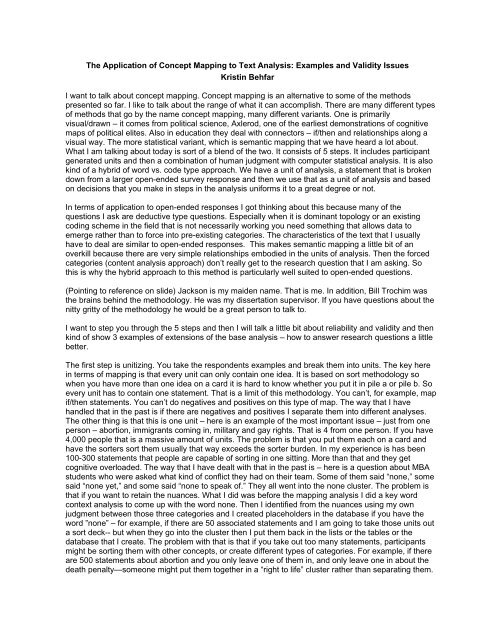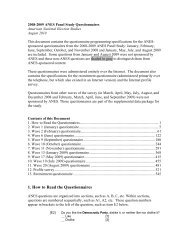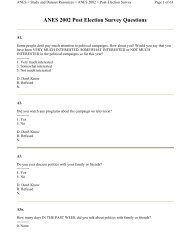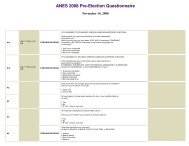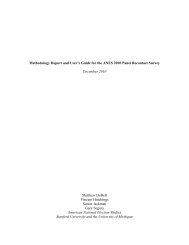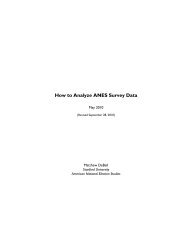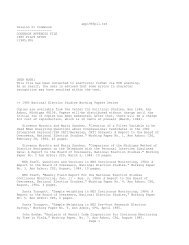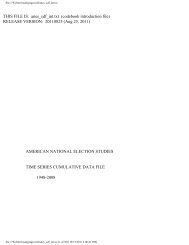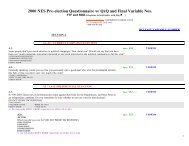The Application of Concept Mapping to Text Analysis: Examples and ...
The Application of Concept Mapping to Text Analysis: Examples and ...
The Application of Concept Mapping to Text Analysis: Examples and ...
Create successful ePaper yourself
Turn your PDF publications into a flip-book with our unique Google optimized e-Paper software.
<strong>The</strong> <strong>Application</strong> <strong>of</strong> <strong>Concept</strong> <strong>Mapping</strong> <strong>to</strong> <strong>Text</strong> <strong>Analysis</strong>: <strong>Examples</strong> <strong>and</strong> Validity Issues<br />
Kristin Behfar<br />
I want <strong>to</strong> talk about concept mapping. <strong>Concept</strong> mapping is an alternative <strong>to</strong> some <strong>of</strong> the methods<br />
presented so far. I like <strong>to</strong> talk about the range <strong>of</strong> what it can accomplish. <strong>The</strong>re are many different types<br />
<strong>of</strong> methods that go by the name concept mapping, many different variants. One is primarily<br />
visual/drawn – it comes from political science, Axlerod, one <strong>of</strong> the earliest demonstrations <strong>of</strong> cognitive<br />
maps <strong>of</strong> political elites. Also in education they deal with connec<strong>to</strong>rs – if/then <strong>and</strong> relationships along a<br />
visual way. <strong>The</strong> more statistical variant, which is semantic mapping that we have heard a lot about.<br />
What I am talking about <strong>to</strong>day is sort <strong>of</strong> a blend <strong>of</strong> the two. It consists <strong>of</strong> 5 steps. It includes participant<br />
generated units <strong>and</strong> then a combination <strong>of</strong> human judgment with computer statistical analysis. It is also<br />
kind <strong>of</strong> a hybrid <strong>of</strong> word vs. code type approach. We have a unit <strong>of</strong> analysis, a statement that is broken<br />
down from a larger open-ended survey response <strong>and</strong> then we use that as a unit <strong>of</strong> analysis <strong>and</strong> based<br />
on decisions that you make in steps in the analysis uniforms it <strong>to</strong> a great degree or not.<br />
In terms <strong>of</strong> application <strong>to</strong> open-ended responses I got thinking about this because many <strong>of</strong> the<br />
questions I ask are deductive type questions. Especially when it is dominant <strong>to</strong>pology or an existing<br />
coding scheme in the field that is not necessarily working you need something that allows data <strong>to</strong><br />
emerge rather than <strong>to</strong> force in<strong>to</strong> pre-existing categories. <strong>The</strong> characteristics <strong>of</strong> the text that I usually<br />
have <strong>to</strong> deal are similar <strong>to</strong> open-ended responses. This makes semantic mapping a little bit <strong>of</strong> an<br />
overkill because there are very simple relationships embodied in the units <strong>of</strong> analysis. <strong>The</strong>n the forced<br />
categories (content analysis approach) don’t really get <strong>to</strong> the research question that I am asking. So<br />
this is why the hybrid approach <strong>to</strong> this method is particularly well suited <strong>to</strong> open-ended questions.<br />
(Pointing <strong>to</strong> reference on slide) Jackson is my maiden name. That is me. In addition, Bill Trochim was<br />
the brains behind the methodology. He was my dissertation supervisor. If you have questions about the<br />
nitty gritty <strong>of</strong> the methodology he would be a great person <strong>to</strong> talk <strong>to</strong>.<br />
I want <strong>to</strong> step you through the 5 steps <strong>and</strong> then I will talk a little bit about reliability <strong>and</strong> validity <strong>and</strong> then<br />
kind <strong>of</strong> show 3 examples <strong>of</strong> extensions <strong>of</strong> the base analysis – how <strong>to</strong> answer research questions a little<br />
better.<br />
<strong>The</strong> first step is unitizing. You take the respondents examples <strong>and</strong> break them in<strong>to</strong> units. <strong>The</strong> key here<br />
in terms <strong>of</strong> mapping is that every unit can only contain one idea. It is based on sort methodology so<br />
when you have more than one idea on a card it is hard <strong>to</strong> know whether you put it in pile a or pile b. So<br />
every unit has <strong>to</strong> contain one statement. That is a limit <strong>of</strong> this methodology. You can’t, for example, map<br />
if/then statements. You can’t do negatives <strong>and</strong> positives on this type <strong>of</strong> map. <strong>The</strong> way that I have<br />
h<strong>and</strong>led that in the past is if there are negatives <strong>and</strong> positives I separate them in<strong>to</strong> different analyses.<br />
<strong>The</strong> other thing is that this is one unit – here is an example <strong>of</strong> the most important issue – just from one<br />
person – abortion, immigrants coming in, military <strong>and</strong> gay rights. That is 4 from one person. If you have<br />
4,000 people that is a massive amount <strong>of</strong> units. <strong>The</strong> problem is that you put them each on a card <strong>and</strong><br />
have the sorters sort them usually that way exceeds the sorter burden. In my experience is has been<br />
100-300 statements that people are capable <strong>of</strong> sorting in one sitting. More than that <strong>and</strong> they get<br />
cognitive overloaded. <strong>The</strong> way that I have dealt with that in the past is – here is a question about MBA<br />
students who were asked what kind <strong>of</strong> conflict they had on their team. Some <strong>of</strong> them said “none,” some<br />
said “none yet,” <strong>and</strong> some said “none <strong>to</strong> speak <strong>of</strong>.” <strong>The</strong>y all went in<strong>to</strong> the none cluster. <strong>The</strong> problem is<br />
that if you want <strong>to</strong> retain the nuances. What I did was before the mapping analysis I did a key word<br />
context analysis <strong>to</strong> come up with the word none. <strong>The</strong>n I identified from the nuances using my own<br />
judgment between those three categories <strong>and</strong> I created placeholders in the database if you have the<br />
word ”none” – for example, if there are 50 associated statements <strong>and</strong> I am going <strong>to</strong> take those units out<br />
a sort deck-- but when they go in<strong>to</strong> the cluster then I put them back in the lists or the tables or the<br />
database that I create. <strong>The</strong> problem with that is that if you take out <strong>to</strong>o many statements, participants<br />
might be sorting them with other concepts, or create different types <strong>of</strong> categories. For example, if there<br />
are 500 statements about abortion <strong>and</strong> you only leave one <strong>of</strong> them in, <strong>and</strong> only leave one in about the<br />
death penalty—someone might put them <strong>to</strong>gether in a “right <strong>to</strong> life” cluster rather than separating them.
What you really want <strong>to</strong> know is that there is an abortion cluster <strong>and</strong> there is a death penalty cluster.<br />
<strong>The</strong> rule I use there is that I leave 20% <strong>of</strong> the <strong>to</strong>tal in. I have never been asked <strong>to</strong> justify the 20%. <strong>The</strong><br />
way that I think about it comes from the literature on affirmative action. For example, they find that 1 in<br />
5 or 20% is the point <strong>of</strong> optimal distinctiveness. <strong>The</strong> other rule <strong>of</strong> thumb is <strong>to</strong> use is a minimum – for<br />
example, if in one category I take only leave10 statements– I always leave the same minimum <strong>of</strong> all the<br />
rest <strong>of</strong> the categories. That is one way <strong>to</strong> get around the scaling-up problem (<strong>to</strong> avoid cognitive<br />
overload in sorters).<br />
Here is an example response that I broke in<strong>to</strong> 2 units. <strong>The</strong> key here is that if you leave more than one<br />
idea in a unit it is almost impossible <strong>to</strong> sort in<strong>to</strong> a discrete pile – <strong>and</strong> in terms <strong>of</strong> multidimensional<br />
scaling, you get a junk cluster in the middle. Unitizing is very, very critical. <strong>The</strong> way I do it, usually it is a<br />
very time consuming process. <strong>The</strong> whole analysis would probably take a couple <strong>of</strong> hours but the<br />
unitizing takes a couple <strong>of</strong> days depending on how many statements you have. I usually have 2<br />
researchers make the unitizing decisions <strong>and</strong> then access inter-coder reliability. Or we have also very<br />
successfully used a group <strong>of</strong> participants who generated statements – 3 or 4 <strong>of</strong> them get <strong>to</strong>gether <strong>and</strong><br />
make collective decisions about what constitutes units. I have done that on interview transcripts <strong>and</strong> on<br />
open-ended question surveys. It depends on how much <strong>of</strong> the participant judgment you want <strong>to</strong> retain<br />
<strong>and</strong> what you think your reviewers will think about the validity.<br />
<strong>The</strong> second step is <strong>to</strong> sort. Here is a hypothetical sort <strong>of</strong> 10 cards. <strong>The</strong> sorters that I choose are usually<br />
the original participants. Sometimes there are confidentiality issues so I can’t use original participants<br />
because for some reason they can identify – in the MBA section – who said what about who. We<br />
remove all the names <strong>and</strong> company references – I usually use the original participants, a minimum <strong>of</strong><br />
10, but I like <strong>to</strong> get about 24. If you can’t use original participants we have what we call proxies. <strong>The</strong><br />
criteria we use in identifying proxies are how much <strong>of</strong> the original experience do they share in terms <strong>of</strong><br />
the validity <strong>and</strong> the interpretation. If they use words that they don’t underst<strong>and</strong> the context <strong>of</strong> the words,<br />
the meaning, then it is very difficult <strong>to</strong> run a sort in the same way that would reflect the original structure<br />
from the participants. <strong>The</strong> second is how much knowledge <strong>of</strong> theory they have. When I was talking<br />
about what conflicts they have on their teams, I had the challenge <strong>of</strong> after a certain point they get an inclass<br />
module on managing conflict. In which case they would reflect the dominant <strong>to</strong>pologies that we<br />
teach <strong>and</strong> the structure wouldn’t necessarily emerge from their perspective. I had <strong>to</strong> make sure I used<br />
people that hadn’t had that theoretical background. That is where my research interest was. <strong>The</strong> third<br />
was how much existing theoretical frameworks can guide your interpretation <strong>of</strong> what they are doing So<br />
for example, in team management we know typically there is a task side <strong>and</strong> a social side. You manage<br />
the task <strong>and</strong> you manage the people where you work. You use those taxonomies <strong>to</strong> underst<strong>and</strong> how<br />
much the sorters are completely blind or how much they do know what they are doing. You can identify<br />
people who aren’t following instructions or aren’t taking the sort seriously. Here is a hypothetical sort –<br />
the instructions are <strong>to</strong> create as many piles as you think conceptually makes sense. It is not queue sort<br />
with forced distribution. <strong>The</strong> only rule that they have is that they can’t create a junk pile. If they don’t’<br />
think a statement belongs in a pile they leave it in its own pile <strong>and</strong> give it a name. When we aggregate<br />
by adding <strong>to</strong>gether all the sorter’s initial matrices—the result is a point map, where the collective (or<br />
aggregate) judgment decides where that point goes on the map. <strong>The</strong> sorters have labeled each <strong>of</strong> their<br />
piles. For this one – 6, 2, 1 & 9 go <strong>to</strong>gether so we create a binary score matrix for each <strong>of</strong> the sorters. In<br />
the database this matrix shows what the piles were <strong>and</strong> each <strong>of</strong> their piles is associated with a label.<br />
<strong>The</strong>n we aggregate just by adding all the matrixes <strong>to</strong>gether. You get an aggregate <strong>and</strong> you do an MDS<br />
on that, an aggregated matrix <strong>and</strong> you get an aggregated picture <strong>of</strong> your relationships between the<br />
statements <strong>and</strong> the units.<br />
I’ll show you a few examples <strong>of</strong> what the statements were so you can see how they fit <strong>to</strong>gether.<br />
[Pointing <strong>to</strong> slide] “Conflict on the best way <strong>of</strong> solving a problem”; “we didn’t know how <strong>to</strong> organize or<br />
approach the work;” “different views <strong>of</strong> the case;” this is mostly task related; “one person always having<br />
<strong>to</strong> be right, sometimes oppressive;” “tremendous personality clashes;” “no open fighting just bottled-up<br />
resentment occasional sarcasm;” so there is overt kind <strong>of</strong> implicit conflict; “some felt lack <strong>of</strong> ownership;”<br />
“conflict regarding team members showing up late or not showing up at all;” “time spent <strong>to</strong>gether was<br />
<strong>to</strong>o long.” Task issues, personal issues, logistical types <strong>of</strong> issues. So the next step here is <strong>to</strong> decide<br />
what <strong>to</strong> do cluster analysis on these coordinates. We have <strong>to</strong> decide what is the final cluster solution
which is another step in the analysis – in choosing who will make this decision, you have <strong>to</strong> decide how<br />
much theory will inform us vs. how much a naive participant will inform us.<br />
Here are the results <strong>of</strong> this one. In this case I used two <strong>of</strong> the original participants <strong>to</strong> decide what is the<br />
cluster solution. So, the “best” cluster solution is a matter <strong>of</strong> human judgment. I chose the original<br />
participants because my brain is already saturated by the dominant taxonomy in the literature. In<br />
instructing the decision makers, what I basically do is print out the dendogram <strong>and</strong> all the related text<br />
for each <strong>of</strong> the points associated with each cluster solution. <strong>The</strong>y work <strong>to</strong>gether <strong>to</strong> make the choice <strong>of</strong> a<br />
solution– when does it make sense that the clusters merge <strong>and</strong> when does it make sense that they stay<br />
distinct <strong>The</strong>y chose this number <strong>of</strong> clusters. I have also done it where I use different demographic<br />
groups <strong>to</strong> see if they come up with different types <strong>of</strong> clusters. For example, I have asked my<br />
pr<strong>of</strong>essional colleagues do the clustering so we could compare their clustering solutions <strong>to</strong> participants.<br />
<strong>The</strong>n we then conduct interviews as <strong>to</strong> what those differences are <strong>and</strong> their interpretations-or you can<br />
assess correlations between ‘expert’ <strong>and</strong> ‘novice’ matrices.<br />
<strong>The</strong> next step is <strong>to</strong> label the clusters. <strong>The</strong>re are a couple <strong>of</strong> ways <strong>to</strong> do the labeling. One way is <strong>to</strong> have<br />
the humans choose it. I typically have the decision makers <strong>of</strong> the cluster analysis choose them. <strong>The</strong>y<br />
are very familiar with the data. <strong>The</strong> other way, the more statistical way, is <strong>to</strong> do a centroid analysis<br />
where you come up with the average X & Y values for each <strong>of</strong> the piles that each participant creates<br />
that is associated with their label. You come up with a centroid for each cluster. <strong>The</strong>n you come up with<br />
a <strong>to</strong>p 10 list using the equivalent distance for each person’s pile – which one is the closest <strong>to</strong> the center<br />
<strong>of</strong> the cluster. You can generate in<strong>to</strong> a “<strong>to</strong>p 10 list” <strong>of</strong> names for each cluster. Usually I give them a <strong>to</strong>p<br />
10 list <strong>and</strong> the participants use that <strong>to</strong> inform their judgment. Usually they want <strong>to</strong> put some kind <strong>of</strong><br />
variant on it.<br />
Here are the results <strong>of</strong> this. In assessing reliability there are a couple <strong>of</strong> things – I use Klaus<br />
Krippendorff’s categories. I have actually never been asked any <strong>of</strong> these questions by a reviewer, ever.<br />
But in terms <strong>of</strong> stability there are a couple <strong>of</strong> ways – the same coder being consistent. You can ask<br />
sorters <strong>to</strong> do sorts at two different times <strong>and</strong> then correlate the matrixes. Reproducibility is a little more<br />
difficult. One way is <strong>to</strong> correlate each individual matrix with the aggregate, like an item <strong>to</strong>tal<br />
assessment. This is really dependent on my choice <strong>of</strong> sorters. Often times a research question you<br />
want <strong>to</strong> know is this reproducible or not<br />
You can compare experts vs. novices <strong>and</strong> individuals vs. the aggregate. Accuracy is very hard. <strong>The</strong>re is<br />
really no solution in this case. I like the other solutions. This is where I think the method can shine.<br />
Some units are harder <strong>to</strong> code than others – that goes away because the participants are doing it. If<br />
they are hard they are left in the middle <strong>and</strong> pulled <strong>to</strong>ward the aggregate. When they do show up in the<br />
middle <strong>of</strong> the map <strong>and</strong> usually in my experience it is because someone made a bad unitizing decision<br />
where it is hard <strong>to</strong> interpret units. In which case you take a second stab at unitizing it or try <strong>to</strong> explain it.<br />
In some cases it is theoretically interesting. I will show you examples <strong>of</strong> that. In other cases where it<br />
does truly reflect <strong>to</strong> researcher error but that has <strong>to</strong> be justified. Some categories are harder <strong>to</strong><br />
underst<strong>and</strong> than others – this kind <strong>of</strong> goes away also because the participants are creating the<br />
categories. Subsets <strong>of</strong> categories can be confused with larger categories – that also does go away in<br />
the aggregate picture. You lose some fine tuning but you get the aggregate picture. I will talk a little bit<br />
more about that later. Individual coders may be careless, inconsistent or interdependent. <strong>The</strong><br />
interdependent goes away. <strong>The</strong>re is no conflict resolution over where this unit belongs. But coders can<br />
be careless for example they don’t follow instructions. One coder I gave him a list <strong>of</strong> conflicts with an<br />
MBA team <strong>and</strong> he divided the statements in<strong>to</strong> two piles <strong>of</strong> conflict: 1) that he personally has<br />
experienced versus 2) those he hasn’t experienced-- rather than <strong>to</strong> create categories <strong>of</strong> conflict. People<br />
can be careless or not follow/misunderst<strong>and</strong> instructions. That is where the matrix correlations from<br />
individual <strong>to</strong> aggregate can really make this apparent. Another example: one <strong>of</strong> the sorters used a<br />
taxonomy he learned about in undergrad that describes different stages <strong>of</strong> group development: forming,<br />
s<strong>to</strong>rming, norming, performing. It is a taxonomy sometimes used <strong>to</strong> describe stages group<br />
development. It didn’t necessarily rely on conflict at all so we threw that one out as well.
In terms <strong>of</strong> validity, this really depends on the choices that you make. Sampling is a big issue here. I<br />
have done a lot <strong>of</strong> research with concept mapping on team level analysis in which case it is very<br />
difficult. You either have all the team members <strong>and</strong> find a way <strong>to</strong> access team level agreement, or use<br />
‘informed experts’ (members who represent their team). I’ll show you a way I have assessed within <strong>and</strong><br />
between team agreement. But one problem with ‘informed experts’ is if you have one person reporting<br />
on what happens, for example, I did a study on negotiation teams, we had one expert informant. You<br />
have <strong>to</strong> make it very clear why the expert informant would represent the team. In this case we sampled<br />
from executive education so they knew the difference between what was within the negotiation team<br />
issue vs. what was across the team issue (an important internal validity concern). We actually wanted<br />
them <strong>to</strong> have some familiarity with theory <strong>and</strong> practice.<br />
For retaining context it is semantical validity issue. <strong>The</strong> unitizing is key; this is where the reviewers go<br />
after me the most. Assessing reliability is very important. <strong>The</strong> statements that show up in the middle <strong>of</strong><br />
the map, that is where I tend <strong>to</strong> focus when I have validity discussions. Is it really a unitizing error or is<br />
there some reason why – [pointing <strong>to</strong> slide] there are some types <strong>of</strong> conflict that are personal but they<br />
are personal because <strong>of</strong> cultural differences – those are the ones that show up in the middle <strong>of</strong> the map<br />
because there are two reasons why there is conflict in that statement but they are hard <strong>to</strong> separate.<br />
That is very difficult.<br />
<strong>The</strong> choice <strong>of</strong> sorters is important for external validity: who are you trying <strong>to</strong> generalize <strong>to</strong> <strong>The</strong><br />
structure that emerges has <strong>to</strong> represent the population that you are trying <strong>to</strong> generalize <strong>to</strong>. In my case<br />
the studies that I do I tend <strong>to</strong> use census, all the MBAs that are on this type <strong>of</strong> team; all the people that<br />
do the negotiations.<br />
Internal validity is almost like a reliability issue in this type analysis.<br />
External reliability is critical <strong>to</strong> the interpretation. This has been tricky both as a researcher, but also<br />
when presenting results <strong>to</strong> participants. As a researcher you rely on the proximal distance <strong>and</strong> the<br />
proximity <strong>of</strong> clusters <strong>to</strong> – does the proximity <strong>of</strong> how the participants sorted <strong>and</strong> viewed different clusters<br />
<strong>and</strong> categories <strong>of</strong> conflict jive with the categories in conflict in literature <strong>and</strong> other taxonomies. We<br />
underst<strong>and</strong> how <strong>to</strong> interpret multidimensional scaling results. But, audiences <strong>and</strong> participants do not<br />
necessarily interpret the maps well. For example, in terms <strong>of</strong> participants it is very interesting; a<br />
colleague <strong>of</strong> mine was involved in a search for a new police chief in the city. Part <strong>of</strong> the problem was<br />
that there was a lot <strong>of</strong> racial tension in the community between the police chief <strong>and</strong> the police force <strong>and</strong><br />
the community. <strong>The</strong>y solicited from the entire community (using newspaper ads <strong>and</strong> suggestion boxes<br />
around <strong>to</strong>wn) what are the <strong>to</strong>p 5 qualities that you want <strong>to</strong> see in a police chief. <strong>The</strong>y did concept<br />
mapping. <strong>The</strong>y went <strong>to</strong> the community in an organizing type meeting. <strong>The</strong>y put up the concept map <strong>and</strong><br />
immediately people started booing. <strong>The</strong> “racial sensitivity” cluster was a very small cluster down at the<br />
bot<strong>to</strong>m. <strong>The</strong> audience figured that since it was small <strong>and</strong> at the bot<strong>to</strong>m it wasn’t very important. <strong>The</strong>y<br />
didn’t underst<strong>and</strong> that it is the spatial relationships that matter. <strong>The</strong> size <strong>and</strong> the shape <strong>of</strong> the cluster<br />
really is not that meaningful. Smaller clusters tend <strong>to</strong> be tighter in terms <strong>of</strong> conceptual clarity but the<br />
bigger clusters don’t mean more important. That is a drawback that I couldn’t have foreseen about this<br />
type <strong>of</strong> methodology. You have <strong>to</strong> be very clear about how <strong>to</strong> interpret the maps—in some cases I<br />
would recommend <strong>to</strong> not show them—just use a list rather than the visual representation if you think<br />
there is any risk.<br />
Now I am going <strong>to</strong> show you three examples that demonstrate the range <strong>of</strong> the methodology. You have<br />
the map which is basically a categorization <strong>of</strong> participant judgment or structure in data. I am going <strong>to</strong><br />
give you three examples on how <strong>to</strong> exp<strong>and</strong> that map. I just published a paper on these categories. Here<br />
is the same map I showed you about the types <strong>of</strong> conflict that exist. I wanted <strong>to</strong> compare this <strong>to</strong> the<br />
expert judgment, the taxonomies that exist, dominating the literature. This is where it is particularly<br />
interesting. <strong>The</strong>re are three types <strong>of</strong> conflict that we talked about – task, relationship <strong>and</strong> process. <strong>The</strong><br />
problem is that task conflict <strong>and</strong> process conflict never separate with fac<strong>to</strong>r analysis, so people just<br />
leave out the construct process conflict. However, process conflict is a critical foundation <strong>of</strong> theory<br />
building in the team’s literature. Look at what I found – these are very close [pointing <strong>to</strong> the task <strong>and</strong><br />
methodology/approach clusters] – I had experts, academics do Likert scale ratings on each <strong>of</strong> the
statements as <strong>to</strong> how much they were related <strong>to</strong> task, how much they were related <strong>to</strong> relationship <strong>and</strong><br />
how much they were related <strong>to</strong> process conflict. <strong>The</strong>n I did a T-test <strong>to</strong> see how if there were significant<br />
differences among the ratings for each item – aggregate item – in each <strong>of</strong> these clusters. What I found<br />
is most significant differences between task <strong>and</strong> process conflict in this cluster or this cluster [pointing <strong>to</strong><br />
the timing/scheduling <strong>and</strong> workload/contribution clusters]. <strong>The</strong> participants judge these <strong>to</strong> be very close<br />
<strong>to</strong>gether. <strong>The</strong> experts could also not tell them apart. So when you look at the current scale that<br />
measures these things, they are measuring this [pointing <strong>to</strong> the work method/approach cluster] but<br />
ignoring this [pointing <strong>to</strong> the timing/scheduling <strong>and</strong> workload/contribution clusters] <strong>and</strong> really these two<br />
are the unique aspects that cause this conflict. This comparison <strong>of</strong> participant vs. expert review was<br />
very useful.<br />
We also used these clusters <strong>to</strong> generate scale items <strong>and</strong> <strong>to</strong> guide open-ended interviews based on<br />
these clusters.<br />
Here is another comparison [next slide]. We wanted <strong>to</strong> see what are the challenges that multicultural<br />
teams have in comparison <strong>to</strong> the challenges that same culture teams have. We asked participants from<br />
two samples (same <strong>and</strong> different culture teams) <strong>to</strong> generate different statements <strong>and</strong> had them do<br />
different mapping. Based on theory, we discuss these two tables that represent participant view about<br />
what is the same <strong>and</strong> what is unique based on culture.<br />
In this example [next slide] I wanted <strong>to</strong> tie three data sources from a survey <strong>to</strong>gether: 1) they type <strong>of</strong><br />
conflict experienced, 2) how they resolved that conflict, with 3) team outcomes <strong>of</strong> performance <strong>and</strong><br />
satisfaction. This is a picture <strong>of</strong> the map from how they resolved conflict. One <strong>of</strong> the clusters was that<br />
“we avoid it”. This is a graph plotting team Likert rating scales for satisfaction against the performance<br />
or grade what they got on a midterm—for the statements in the “avoid it” cluster. I looked at the<br />
differences in the quadrants. I think looked closer a the qualitative differences in the quadrants. What I<br />
found was that the teams that were low performance/low satisfaction, they were defining avoid as<br />
“sweeping it under the rug/divide <strong>and</strong> conquer/minimize our misery.” <strong>The</strong> high performance/high<br />
satisfaction people were defining avoid as “working hard <strong>to</strong> prevent.” <strong>The</strong> low satisfaction/high grade<br />
which was the majority <strong>of</strong> the people in the class, defined avoid as “preventing escalation.” <strong>The</strong><br />
taxonomy, the dominate taxonomy, <strong>of</strong> conflict <strong>and</strong> management has avoidance as one <strong>of</strong> the strategies<br />
but when it is aggregated <strong>to</strong> the team level it doesn’t capture the nuances <strong>of</strong> what the word avoid<br />
means depending on the experience <strong>and</strong> the trade<strong>of</strong>fs they make on conflict resolution.<br />
Because I was trying <strong>to</strong> capture team-level strategies, I had <strong>to</strong> assess within-team agreement. A<br />
challenge with qualitative data. <strong>The</strong> way I did this was <strong>to</strong> use the fact that we have three criteria for<br />
evaluating team viability one is performance, one is satisfaction <strong>and</strong> one is that the team’s process has<br />
<strong>to</strong> enhance its ability <strong>to</strong> work <strong>to</strong>gether in the future. So, on this graph, one quantitative dimension is<br />
satisfaction <strong>and</strong> the other is performance. What I am plotting is process—or the results <strong>of</strong> the concept<br />
mapping analysis. To assess within team agreement, all members had <strong>to</strong> report experience the same<br />
conflict types <strong>and</strong> associate them with the same strategies. To assess inter-team agreement about<br />
which strategies were applied <strong>to</strong> which type <strong>of</strong> conflict, at least 1/3 (<strong>to</strong> reflect that there are three types<br />
<strong>of</strong> conflict) had <strong>to</strong> report applying the same strategy <strong>to</strong> the same type <strong>of</strong> conflict.<br />
<strong>The</strong> last example I wanted <strong>to</strong> show you was how you predict behaviors <strong>and</strong> attitudes from the fact that a<br />
participant has a statement that belongs in a particular cluster. This is a study I did on negotiating<br />
teams. <strong>The</strong>re is broad literature on teams <strong>and</strong> broad literature on negotiation. But there is very little<br />
research on how challenges within these teams impact their across-the-table strategy. We did two<br />
maps on what were the challenges they have <strong>and</strong> how did they manage them; not across the table,<br />
only on the same side <strong>of</strong> the table. When we unitized the interviews <strong>and</strong> we had <strong>to</strong> throw out all the<br />
across the table utterances. We unitized by going through the interview transcripts. Three researchers<br />
used highlighters <strong>to</strong> say this is a challenge, <strong>and</strong> marked the associated solution. In our database we<br />
had the unit, the challenge, the associated management strategy, their home industry, the number <strong>of</strong><br />
people on the team – all those things we had <strong>to</strong> control for. <strong>The</strong>n we did a thing called pattern coding.<br />
You take smaller number <strong>of</strong> categories <strong>and</strong> create meta-categories. Based on existing theory, we came<br />
up with “global” categories represented by spatial regions on the maps. Each <strong>of</strong> these clusters [pointing
<strong>to</strong> map] belongs in a meta category. <strong>The</strong> problem with doing that is – <strong>and</strong> the problem with interview<br />
data – if you get a particularly verbose person you might generate many, many units <strong>and</strong> this can dis<strong>to</strong>rt<br />
the distribution <strong>of</strong> meaning in a cluster. What we ended up doing was constraining participants <strong>to</strong> one<br />
statement in each <strong>of</strong> these clusters. For example, if a person had 3 statements in one cluster, we only<br />
allowed 1 <strong>of</strong> those statements <strong>to</strong> be in the analysis. However, if a person had one statement in each <strong>of</strong><br />
3 clusters in a meta-category, we allowed it. A person that clustered a statement in all three <strong>of</strong> these,<br />
we allowed them but if they<br />
<strong>The</strong>n we did a Chi square analysis <strong>to</strong> see if you are in this meta-category what is the likelihood that you<br />
will be in another midi-category <strong>The</strong>n we looked for interdependencies because all teams have<br />
multiple challenges. We looked for interactions <strong>to</strong> see if you have interpersonal differences that affect<br />
your ability <strong>to</strong> find a resolution <strong>to</strong> task differences. What we found, contrary <strong>to</strong> what the negotiation<br />
literature would say, is that if you have task differences (that you are not able <strong>to</strong> formulate coherent<br />
same side strategy) – they actually did better across the table <strong>and</strong> had more positive receptions <strong>of</strong> the<br />
process, because by engaging in that strategy discussion the range <strong>of</strong> issues on the radar are<br />
exp<strong>and</strong>ed so they tend <strong>to</strong> address the interpersonal issues in a much more constructive way. <strong>The</strong> way<br />
that they did it based on the matches that we made across the maps was that they rehearsed. If so <strong>and</strong><br />
so said this… That way they were able <strong>to</strong> maintain team discipline <strong>and</strong> prevent the other team from<br />
dividing <strong>and</strong> conquering them which is a common strategy between groups.<br />
<strong>The</strong>se are the practical issues I want <strong>to</strong> cover because I am almost out <strong>of</strong> time—they represent the<br />
advantages, disadvantages, <strong>and</strong> range <strong>of</strong> the methodology. It is a good fit for the nature <strong>of</strong> open-ended<br />
responses; especially with the organization surveys that I do that tends <strong>to</strong> be kind <strong>of</strong> a free listing<br />
context type <strong>of</strong> test. <strong>The</strong>y don’t rely on preconceived coding schemes. <strong>The</strong> research questions I was<br />
asking were primarily explora<strong>to</strong>ry or inductive; I wanted <strong>to</strong> see what was wrong with the dominate<br />
taxonomies <strong>and</strong> why are they not empirically supported <strong>The</strong> method preserves the context <strong>of</strong> the<br />
concept in the unit <strong>of</strong> analysis. As I showed the nuances <strong>of</strong> the word can be quite different. It is the<br />
same word. <strong>The</strong>re are also considerable time savings – the unitizing takes the longest, sorting typically<br />
takes 20-60 minutes, it takes decision makers no more than 2 hours <strong>to</strong> choose a final cluster solution<br />
<strong>and</strong> labels. It is nice compared <strong>to</strong>, I was once involved in a content analysis project that <strong>to</strong>ok us three<br />
weeks <strong>of</strong> fulltime work. It is a considerable time savings.<br />
For the challenges – you have <strong>to</strong> have access <strong>to</strong> the units <strong>of</strong> analysis. You just have <strong>to</strong>. <strong>The</strong>re is no way<br />
<strong>to</strong> do it without them. <strong>The</strong>re is a sorter burden. If you get beyond 300 units it can be difficult. Complex<br />
text, I tried <strong>to</strong> do this with restaurant hiring data. “I would hire this person if he had these three qualities<br />
but not this one.” You can’t map that with this. You need a more sophisticated mapping analysis for<br />
if/then relationships. Dense text is particularly difficult <strong>to</strong> unitize. In the interview transcripts that we<br />
unitize you <strong>of</strong>ten get a paragraph so the sorting endeavor becomes a different kind <strong>of</strong> sort. It is not just<br />
concepts, but it is putting practices in<strong>to</strong> categories rather than just concepts. I have found that you have<br />
<strong>to</strong> have more sorters when the units are more complex. <strong>The</strong> other thing with dense text that reviewers<br />
have had trouble with – they <strong>of</strong>ten look at the stress value <strong>of</strong> the multidimensional scaling as a reliability<br />
estimate <strong>and</strong> it is really not because I am constraining it <strong>to</strong> two dimensions. It isn’t a good indication on<br />
how much agreement there is among the sorters. Thank you.


